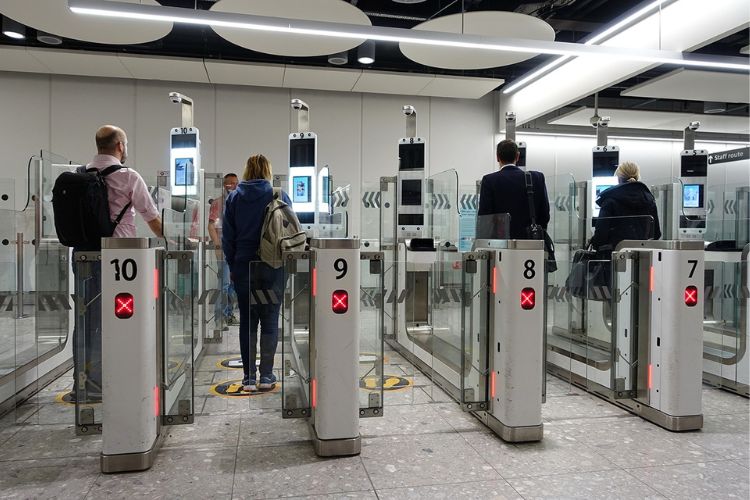Traveling from the UAE to Europe has always been simple for most residents, a visa-free entry for up to 90 days and a quick passport stamp on arrival. But starting October 12, 2025, that process is changing.
The Schengen entry-exit system uae, a digital border control system that will record travelers’ information electronically instead of stamping passports. It’s one of the biggest shifts in Schengen border management in decades, designed to improve security, reduce overstays, and make future entries faster.
If you’re planning to visit France, Italy, Spain, Greece, Germany, or any other Schengen country, here’s everything you need to know about how the new EES system will affect UAE travelers.

What is the Entry-Exit System (EES)?
The EES is an automated IT system created by the European Union to track when and where non-EU nationals enter and exit the Schengen Area.
Currently, travelers’ passports are stamped manually, which can lead to errors or missed entries. The new system replaces that with digital records that include:
- Entry and exit dates and locations
- Facial image and fingerprints
- Passport and travel document details
- Any recorded refusals of entry
This data will be stored securely for up to three years, giving authorities an accurate way to calculate each visitor’s stay duration and identify overstays instantly.
Why Is the EU Introducing EES?
With millions of tourists entering Europe every year, the EU needed a faster and more reliable border system.
EES aims to:
- Enhance security and border management
- Eliminate manual passport stamping
- Identify overstayers automatically
- Speed up border control for frequent travelers
In short, the system helps both travelers and border officers, fewer errors, shorter lines in the future, and greater confidence that your movements are recorded correctly.

What Does This Mean for UAE Travelers?
UAE citizens can continue to visit Schengen countries without a visa for short stays (up to 90 days within 180 days). But the EES means that each entry and exit will now be electronically logged, and first-time travelers will need to register their biometric data at the border.
Here’s how the process will look:
- Arrival at the airport: Border officers will scan your passport.
- Biometric capture: A camera will take your facial image, and you’ll scan four fingerprints.
- System registration: Your data will be uploaded into the EES database.
- Verification: On your next trip, the system will automatically recognize your identity, making clearance faster.
Refusing biometric capture is not allowed, travelers who decline will be denied entry into the Schengen Area.
Good news: Even with the new EES system, UAE residents still enjoy visa-free access to many destinations worldwide, including Europe and beyond. If you’re planning your next getaway, explore our full list of Visa-free countries for UAE Residents and see where you can travel without any extra stress.
Traveling with Family or Children
If you’re traveling as a family from the UAE, the process is simple:
- Children under 12 will only have their photo taken, no fingerprints.
- Children aged 12 and above must provide both a facial image and fingerprints.
- Parents or guardians should accompany minors during biometric registration.
This ensures a child-friendly, secure process without unnecessary complications.

Pre-Travel Checklist for UAE Visitors to Europe
To make your journey smooth under the new system, keep this checklist handy before your next trip:
- Check Passport Validity: It must be valid for at least three months beyond your intended return date.
- Stay Within the 90/180-Day Limit: The EES will automatically track your stay period.
- ETIAS Application (coming soon): Once launched, UAE nationals must apply online for ETIAS, a separate pre-travel authorization.
- Prepare for Longer Queues Initially: Border processing might take a bit longer in the first months after launch.
- Carry Supporting Documents: Flight tickets, hotel bookings, and proof of return travel may still be requested.
- Use the Same Passport: Always travel with the passport linked to your ETIAS authorization once it’s required.
With these steps, UAE residents can travel to Europe confidently and avoid any last-minute stress.
Your Data and Privacy
The EU Entry-Exit System database is managed under the EU’s General Data Protection Regulation (GDPR), one of the strictest privacy frameworks in the world.
Your information is:
- Stored for three years (or longer only if legally necessary)
- Accessed only by authorized border or law enforcement agencies
- Automatically deleted after expiration
This ensures your biometric and travel details remain secure and private.
Timeline of the EES Rollout
| Phase | Timeframe | Details |
|---|---|---|
| Launch | October 12, 2025 | EES begins at selected airports and borders |
| Transition | Oct 2025 – Apr 2026 | Gradual rollout across Schengen countries |
| Full Implementation | April 2026 | Passport stamps completely replaced by digital records |
Benefits for Frequent Travelers from the UAE
Once registered, UAE citizens visiting Europe regularly will experience:
- Faster clearance at immigration on future trips
- Accurate stay tracking through automated records
- More secure travel with biometric verification
- Simplified border checks across all Schengen countries
The EU Entry-Exit System is designed to make travel more efficient for everyone, once the initial transition phase is complete.
Final Thoughts
The EU Entry-Exit System (EES) marks a major milestone in Europe’s move toward smarter and safer travel.
For UAE travelers, it’s important to understand that this isn’t an extra visa step, it’s a modernization of border control.
While the first few months might mean slightly longer waits at immigration, the long-term benefits are clear: faster processing, fewer errors, and enhanced security.
Plan early, stay informed, and travel confidently knowing you’re ready for Europe’s next-generation border system.
FAQs
What is the Schengen entry-exit system uae?
The EES is a new electronic border system launching on October 12, 2025, that replaces passport stamping for non-EU travelers. It records entry and exit dates, biometric data (fingerprints and facial image), and passport details for easier, faster, and more secure travel across Schengen borders.
Will UAE travelers need to register for EES before traveling?
No, UAE citizens and residents do not need to pre-register. The registration happens automatically at the EU border, where your passport, photo, and fingerprints will be recorded the first time you enter a Schengen country after the system starts.
Does EES affect visa-free travel for UAE citizens?
No, the visa-free access for UAE citizens to Schengen countries remains the same. EES only changes how your entry and exit are recorded, from manual passport stamps to digital biometric registration.
Who is exempt from the EU Entry-Exit System?
EES does not apply to EU/EEA/Swiss citizens, holders of residence permits or long-stay visas, and nationals of Andorra, Monaco, San Marino, and Vatican City. Short-stay UAE travelers visiting Europe are not exempt.
What’s the difference between EES and ETIAS?
EES is a border control system that records your entry and exit, while ETIAS is a pre-travel authorization that visa-free travelers (including UAE citizens) will soon need to apply for before entering Europe. ETIAS is expected to launch after EES.





